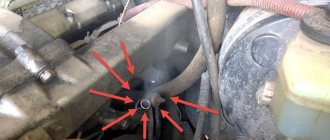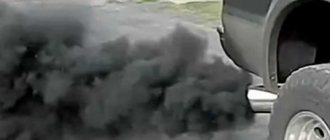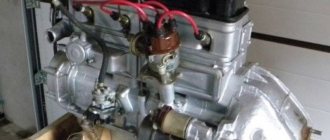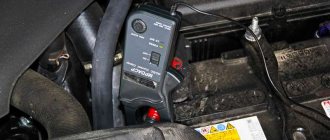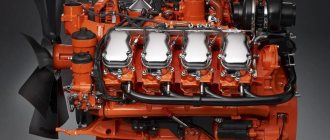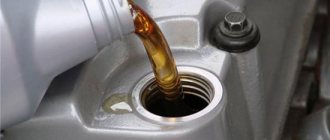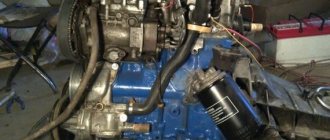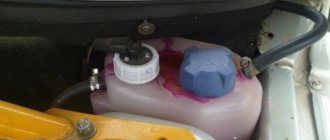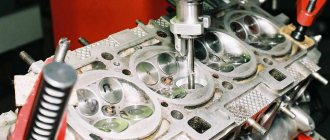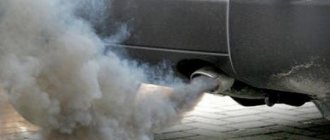Why is diesel breathing?
The concept that the engine is breathing means the appearance of smoke from the oil filler neck, engine oil leaks in various places due to the design of the internal combustion engine (breather), as well as in the area where numerous seals (oil seals) are located. It should be noted that even a relatively new diesel or gasoline engine can breathe a little.
The breather is a device that is a valve. This valve serves to equalize the pressure in containers for various purposes by communicating with the atmosphere. In an internal combustion engine, the breather equalizes the internal pressure in the engine crankcase with the external atmospheric pressure.
The fact is that some of the gases in the cylinder rupture through the sealing rings and enter the engine crankcase, creating excess pressure. To solve this problem, a crankcase ventilation system was created.
Under certain conditions, the crankcase ventilation system does not always successfully cope with increased pressure and removal of excess through the breather. The result is a noticeable increase in oil consumption and oil seal leaks. Sometimes the pressure in the engine rises to such a level that the oil dipstick simply squeezes out.
Why does crankcase pressure increase?
Having noticed oil leaks in the engine compartment and/or a decrease in the oil level in the crankcase, it is necessary to accurately determine that the diesel engine is breathing. This can be done in the following way. It is enough to unscrew the oil filler cap on a warm diesel engine. If you notice bluish smoke coming from the throat, then the problem is obvious.
Cylinder piston group and cylinder head
The main reason that a diesel engine is breathing is the wear of the cylinder-piston group. During the operation of the internal combustion engine, scuffs form on the cylinder walls, the cylinders themselves gradually break and acquire a changed shape of the walls, and the piston rings wear out or break. As a result of heating, the thermal gaps between the piston and the cylinder walls become too large.
In addition to reducing the efficiency of the seal, wear of the rings and their coking are imposed, which deprives the rings of mobility. In such conditions, engine oil enters the combustion chamber abundantly, and the diesel engine emits blue smoke. Also, the gases formed during the combustion of the fuel-air mixture and the engine oil entering the cylinders actively fill the engine crankcase.
If the diesel engine is very worn out, then a major overhaul is necessary, which will mean boring the cylinders, replacing pistons, rings, etc. Accurate diagnosis of CPG problems requires measuring compression to determine the spread of indicators across the cylinders.
In the event that the diesel engine does not breathe much and the malfunction is only at the initial stage (wear of the cylinder walls is within acceptable limits), some auto mechanics resort to the method of decarbonizing the piston rings. This measure is considered temporary, since further long-term operation of the unit after decarbonization of the rings should not be expected. The best solution would be to replace the rings with new ones.
A diesel engine can also vent due to wear of valves, guide bushings, valve seals, etc. Similar to piston malfunctions and ring decarbonization, timing problems can only be effectively eliminated by comprehensive repairs. Replacing valve seals alone does not have a lasting effect.
Engine crankcase ventilation system
Second on the list of main reasons why a diesel engine is breathing is a clogged crankcase ventilation system. The symptoms of a decrease in the throughput of this system resemble wear of the CPG: increased consumption of engine oil, diesel smoking with blue smoke, etc. In some cases, it is possible to normalize engine operation and eliminate excess oil consumption by cleaning the breathers.
Symptoms
The first, main symptoms that the diesel engine has begun to breathe are lubricant leaks and a decrease in the oil level in the crankcase. Having noticed such characteristic phenomena, you need to make sure your suspicions are correct. To do this, you need to warm up the engine to operating temperature, unscrew the oil filler cap and observe the presence of gray smoke.
If the suspicion is confirmed and smoke is present, the diagnosis is clear. Inhale the reasons for the appearance of a diesel engine and how to fix it, we will try to figure it out.
Breather oil: what to do and how to find the cause
Let's start with the fact that during engine operation, so-called crankcase gases accumulate in the crankcase. To prevent excess pressure from being created, there is a special valve for ventilation. This solution allows the closed crankcase to communicate with the atmosphere. This valve is the breather. In simple words, a breather on an internal combustion engine is actually needed to equalize the pressure inside the engine.
It should be noted that in the crankcase gases mix with oil mist. As a result, lubricant particles enter the breather. Although there is a special oil trap inside the device, a certain part of the oil may escape out. Given this information, minor contamination of the system is acceptable, which is normal. In cases where a lot of lubricant leaks, you should look separately for why oil is leaking from the breather.
On injection engines, traces of oil getting into the throttle area are noticeable, the power unit also loses its throttle response and power, and fuel consumption increases noticeably. It turns out that to check it is necessary not only to inspect the outer surfaces under the hood, but also to remove the air filter, throttle assembly, etc.
Why does oil leak through the breather?
If oil appears from the breather, there may be several reasons
Taking into account various features, before self-diagnosis, you need to pay attention to additional symptoms
- First of all, the oil presses as a result of significant wear of the piston rings. This means that gases from the combustion chamber penetrate through the seal into the crankcase, after which too high pressure is created there. Excess pressure causes oil to flow out through the breather.
- Another possible cause could be a clogged oil deflector drain. In this case, gases and oil particles that are no longer able to pass through normally exit through the breather rather than through the cleaner.
- Also on the list is a significant reduction in air filter capacity. In this case, the engine simply does not have enough air at the inlet. The result is the appearance of oil in the filter housing and on the filter itself.
- Possible problems with the breather itself should not be ruled out. As a rule, the valve fails, the passage hole in the breather becomes clogged, etc. Normal ventilation is disrupted, exhaust gases enter the internal combustion engine crankcase and increase the pressure.
- In some cases, overfilling engine oil much higher than the recommended level causes the excess to leak out through the breather. It turns out that excess oil simply presses out of the engine. In such a situation, you should check the lubricant level and adjust it if problems are detected.
The engine smokes white smoke
White smoke during warm-up mode is often just steam that condenses in the exhaust system. Steam will be visible until the exhaust heats up. You can also see drops of water at the end of the pipe. If the outside temperature is low, then steam will be visible even after the engine warms up and reaches operating temperature. The density of such smoke is additionally influenced by air humidity. If the humidity is high, then there will be more smoke.
The appearance of a thick cloud of white smoke in the warm season after the internal combustion engine has warmed up often indicates that it is getting into the cylinders. A common cause of sudden white steam smoking is previous engine overheating. Water is a component that is present in the coolant. It turns out that some of the water does not have time to evaporate in the combustion chamber. Coolant ingress can occur as a result of destruction of the gasket or cracks in the passage of the cooling jacket channels through which the coolant moves.
White smoke is a vapor that easily dissipates into the air. To check, you can attach a sheet of clean paper to the exhaust pipe. The water will gradually dry on the sheet without leaving any distinct greasy marks.
The next step in diagnosis is to check the cooling system for exhaust gases. To do this, simply unscrew the radiator cap or expansion tank cap with the engine off. If you smell the exhaust, there is a film of oil in the fluid itself and the fluid level is low, then the malfunction is obvious. Starting the engine in this case will lead to a significant increase in pressure and an increase in the coolant level in the tank. You can also observe gas bubbles and even seething in the tank.
Subsequent stopping of the engine will cause the level to drop and the coolant will partially flow into the cylinder. From the cylinder, the liquid seeps through the piston rings and ends up in the oil pan, mixing with the lubricant and diluting the engine oil. It turns out a kind of emulsion, the color of the oil changes and the lubricant becomes cloudy.
The entry of coolant into the lubrication system is diagnosed by analyzing the cylinder head cover and the oil filler plug. A light foam appears on the inside of the lid, which has a yellowish tint. The presence of emulsion in the oil can also be seen on the oil dipstick.
We recommend: How to replace brake discs on a VAZ-2114 yourself
A large amount of coolant in the lubrication system will indicate a serious crack or burnout. In some cases, liquid may accumulate in the space above the piston, making it difficult to start the engine. It is worth adding separately that in such a situation there is also a high risk of water hammer. With minor coolant leaks, an emulsion may be present on the cap, but other signs will not be immediately noticeable.
Fault diagnosis
You can more accurately determine the problem cylinder in the following ways:
- Unscrew the spark plugs and check their condition. Coolant tends to “wash out” the spark plug in a faulty cylinder.
- Align the crankshaft so that the intake and exhaust valves are closed. Next, you need to apply compressed air through the spark plug hole, and then look into the expansion tank. An increase in coolant level as a result of air supply will directly indicate a faulty cylinder.
- Remove the cylinder head to check the gasket and adjacent surface of the head. If no defects are identified, then the head is checked for tightness under pressure;
- Perform cylinder diagnostics. To do this, the piston must be lowered to BDC and the walls checked for cracks;
- Check the intake manifold gasket. This is done if, in a particular internal combustion engine, such a gasket structurally serves to seal the coolant circulation channels.
Cleaning the crankcase ventilation system of VAZ 2108, 2109, 21099 cars
Contamination of the engine crankcase ventilation system on VAZ 2108, 2109, 21099 vehicles leads to a decrease in the efficiency of removing crankcase gases from it into the carburetor and further into the afterburning cylinders. As a result, the pressure in the crankcase increases.
The engine oil located there under pressure begins to be expelled through the crankshaft and camshaft seals, the valve cover gasket, its oil filler plug, and is thrown into the air filter housing. As a result, the carburetor becomes clogged, the engine begins to “trouble” and stall, the spark plugs become covered with soot, power and throttle response decrease, engine oil waste increases, etc.
Similar symptoms may occur when the engine piston group wears out (rings, pistons, cylinders), but since you need to start looking for the cause of the malfunction from the simplest, you should first clean the ventilation system, since this is less expensive and problematic than a major engine overhaul. The piston can then be checked by measuring the compression in the engine cylinders.
The procedure for cleaning the crankcase ventilation system of an engine with a Solex carburetor 2108, 21081, 21083 and similar ones
We sequentially remove and clean the elements of the small and large branches of the crankcase ventilation. For cleaning we use acetone or gasoline, a toothbrush, and copper wire. We blow with compressed air from a pump or compressor, simultaneously controlling the ease of its passage.
— Cleaning the breather
There is no need to remove it from the engine, just clean the crankcase gas exhaust channel from contaminants with a brush soaked in gasoline. Blow with compressed air. See photo above.
— Cleaning the large exhaust hose
We disconnect it from the pipe on the engine valve cover and from the breather. We wash it with gasoline (pour it inside and shake it, then pour it with water). Blow with compressed air.
the large exhaust hose of the crankcase ventilation system of VAZ 2108, 2109, 21099 cars is removed from the pipe on the cover and the breather
— Clean the crankcase gas exhaust hose into the cavity of the engine air filter housing
Disconnect the hose from the fitting on the valve cover. Remove the air filter housing. Disconnect the hose from the body. We clean the hose itself and the pipe under it on the air filter housing.
hose for exhausting crankcase gases into the engine air filter housing and its pipe on the removed and inverted air filter housing
— Clean the crankcase gas exhaust hose into the throttle body
Disconnect it from the fittings on the carburetor and on the valve cover. We spill, we blow.
— Cleaning the oil separator
To access the oil separator, you must remove the engine valve cover. After unscrewing the two 10mm bolts, disconnect the oil separator from the inner surface of the valve cover. We wash the oil separator with gasoline. Blow with compressed air. Refer to "Cleaning the Oil Separator for Engines 2108, 21081, 21083".
— We clean the fitting and channel with a calibrated hole in the Solex carburetor
Can be cleaned using copper wire without removing the carburetor from the engine. After cleaning, blow with compressed air. In case of severe contamination, the carburetor will have to be removed to clean them.
cleaning the channel and crankcase gas outlet fitting behind the throttle on a Solex carburetor using copper wire
After cleaning, we install all the elements of the engine crankcase ventilation system back, if necessary, replacing the hose clamps or the hoses themselves, if damaged. During the operation of the car, we check whether the oil leakage under the oil seals and seals has stopped. If not, check the serviceability of the engine piston group.
Notes and additions
— On engines 2111 of VAZ 2108, 2109, 21099 cars, cleaning the ventilation system is done in the same way, taking into account the fact that there is no carburetor, but a throttle body with a fitting for a thin hose of the small branch of crankcase ventilation from the valve cover.
— After cleaning the ventilation system on a carburetor engine, it makes sense to clean the air jets of the GDS carburetor of the Solex carburetor and replace the filter element of the engine air filter.
More articles on engines of VAZ 2108, 2109, 21099 cars
— Engine crankcase ventilation system 2108, 21081, 21083, diagram
— Engine crankcase ventilation system 2111, diagram
— Burnt out valve, signs, causes
Checking the ventilation system
Let's consider it using the example of a VAZ-2110 car.
- The pipes are disconnected from the breather, valve cover and air pipe. Their level of contamination is checked. If necessary, they can be washed in gasoline and dried.
- The nuts are unscrewed, after which the cover is removed. Inside there are 2 bolts connecting the oil separator roof, which will need to be unscrewed.
- The unscrewed cap is removed and the oil separator is removed. It is made of plates that can be easily disassembled and washed.
On other machines, the system design may look different. Therefore, its parsing will be performed differently. But this will not change the essence of the actions. All components will need to be removed and washed.
Gas control has been optimized using rotary valves or diaphragm valves. Oscillating valves are controlled by the crankshaft, diaphragm valves are controlled by gas pressure. To achieve the highest possible output, at least in a limited speed range, gas exchange optimization was performed using pulsed oscillation in the exhaust and suction line.
Depending on the direction of rinsing, which affects the characteristics of the engine, two-stroke engines are divided into 4 at. Duty cycle in a two-stroke spark ignition engine. cross motors, backwash and DC wash. Pressure Compressor Test Test Check the eyepiece and pressure sensor so that it can stabilize the fuel injector seal position seals on the engine. If the measurement results are poor, even with a small number of kilometers of torque, it is possible to obtain local damage caused by engine damage, even if a large number of kilograms of studs is associated with significant wear of some functional groups.
It is easy to inspect and flush the old gas release control valve. It is necessary to remove it and check the stroke of its rod. If it jams a little, then the valve just needs to be washed with gasoline, dried and put back in place.
The following conditions are a prerequisite for a correct compressed air pressure test: the engine has reached operating temperature; decompression engine, i.e. that all ignition and/or glow plugs or all injection nozzles; the throttle is fully open; complete starter power supply; set the prescribed valve clearance; even the start time; for injection engines, all injection pipes are closed; To ignite the transistor, the center connector is removed from the ignition box to prevent damage.
This completes the work of inspecting and flushing the crankcase ventilation. They are simple, so any car enthusiast can handle them.
It is important to note that you should clean the ventilation system every time you change the oil.
Typically, problems with oil escaping through the breather do not appear immediately. They grow gradually. As a result, the engine can lose up to 1 liter of lubricant in a short time. At this moment, car owners begin to think about the problem of why oil is coming out of the breather. This situation is very scary. It is further aggravated by the lack of experienced diagnostic specialists in car service centers. Usually, after diagnostics, car owners disassemble the power unit. But it would be enough to reduce the level of “consumables” or clean the breather.
If the compression pressure of individual cylinders is to be accurately measured, the conditions must be the same as when driving. If the engine is cold, the compression pressure is lower because the heating of the intake air during compression is still relatively small. The measured value does not correspond to the motion coefficients. However, in an engine with poor starting behavior, when the ignition, initial speed, valve clearance and injection system have already been checked, measuring the compression pressure even when the engine is cold can be useful.
When the spark plugs or injectors are unscrewed, the engine reaches higher speeds when rotated by the starter, which more closely matches normal operating conditions than lower cranking speeds. The throttle must be fully open for the engine to draw in enough air. If the throttle is not fully open or closed, the test drum cannot suck enough and therefore also has relatively low compression. Compressed air pressure test values are reported by vehicle manufacturers, distinguishing between specified and minimum values.
Increase in crankcase pressure
When the engine operates, high pressure arises in its cylinders as a result of the release of energy from the combustion process. Under normal conditions, exhaust gases should be discharged from the engine into the atmosphere. However, if the seal between the cylinder and the O-rings is broken, some of the gases may break through and enter the crankcase of the unit, after which excess pressure will form there. The solution to this problem was to create a gas ventilation system in the crankcase.
There are times when the system cannot cope with a large influx of exhaust gases and remove them as intended. In this case, the engine begins to actively consume oil, leaks occur through the oil seals and seals, and there were times when the oil dipstick was squeezed out of the neck due to an excess of gas forces.
The very first, simple motors had a hole with a special oil reflector to remove excess gases, in order to avoid its overconsumption. In modern units, excess gases flow to the air filter, and from there again to the engine; some designs simply discharge them into the manifold.
Troubleshooting
The first thing you need to pay attention to is the color of the exhaust, blue or black smoke, a sign of burnt valves or problems with rings. Next you should check the compression in all cylinders
The value on gasoline internal combustion engines should be within 11-13 MPa. Disconnect the pipes from the valve covers, air vent and breather. Assess the degree of contamination. If the pipes are very dirty or clogged with oil deposits, use gasoline to clean them or a special carburetor cleaner. Check the condition of the oil separator. Unscrew the required bolts to get to this unit. Remove the oil separator and assess its condition. If necessary, clean or rinse followed by drying. Inspect and, if necessary, flush the breather valve. There are situations when the valve gets stuck, resulting in exhaust gases entering the crankcase and creating excess pressure. Remove the part and wash it; in most cases, this will resolve the issue of squeezing oil out of the breather.
Read more: Wires for lighting a car with your own hands
Helpful advice! To distinguish stuck rings from a burnt-out valve, it is enough to perform several manipulations. After checking the compression in the cylinders, determine the cylinder with the lowest value. Then inspect the spark plug of this cylinder; if the rings are lodged in this cylinder, the spark plug will be covered with a thick oil layer. If the valve is burnt out, the spark plug will appear normal without any major abnormalities.
Finally…
The problem of oil escaping through the breather worries many motorists and causes a lot of trouble, but with timely detection of the problem and the right approach, serious consequences can be avoided
It is important to ensure that the oil level is normal, as soon as you find that the engine is taking oil, monitor its level and constantly monitor that it does not fall below the permissible level
Also pay attention to the breather and filter; oil on the air filter in large quantities also does not bode well. Regularly monitor the condition of the engine and all systems, and also promptly correct any malfunction
This will save you from engine overhauls and unnecessary waste.
Any type of car engine has a complex structure. It includes various systems and mechanisms that interact with each other. To ensure the removal of gases formed in the internal cavities of the power unit, the diesel engine is equipped with an effective ventilation system.
Breather oil: what to do and how to find the cause
Let's start with the fact that during engine operation, so-called crankcase gases accumulate in the crankcase. To prevent excess pressure from being created, there is a special valve for ventilation. This solution allows the closed crankcase to communicate with the atmosphere. This valve is the breather. In simple words, a breather on an internal combustion engine is actually needed to equalize the pressure inside the engine.
It should be noted that in the crankcase gases mix with oil mist. As a result, lubricant particles enter the breather. Although there is a special oil trap inside the device, a certain part of the oil may escape out. Given this information, minor contamination of the system is acceptable, which is normal. In cases where a lot of lubricant leaks, you should look separately for why oil is leaking from the breather.
Oil leaks through the breather lead to clogged channels, in some cases soot is formed, etc. Excess soot gets into the engine crankcase, and the lubrication system becomes coked. As a result, loaded parts are less well lubricated and engine wear accelerates. Let us add that traces of oil will not necessarily be visible from the outside in the engine compartment. On engines with a carburetor, if there is a leak through the breather, oil in the air filter housing or on the filter element itself is a characteristic sign of a malfunction.
On injection engines, traces of oil getting into the throttle area are noticeable, the power unit also loses its throttle response and power, and fuel consumption increases noticeably. It turns out that to check it is necessary not only to inspect the outer surfaces under the hood, but also to remove the air filter, throttle assembly, etc.
Why does oil leak through the breather?
If oil appears from the breather, there may be several reasons
Taking into account various features, before self-diagnosis, you need to pay attention to additional symptoms
- First of all, the oil presses as a result of significant wear of the piston rings. This means that gases from the combustion chamber penetrate through the seal into the crankcase, after which too high pressure is created there. Excess pressure causes oil to flow out through the breather.
- Another possible cause could be a clogged oil deflector drain. In this case, gases and oil particles that are no longer able to pass through normally exit through the breather rather than through the cleaner.
- Also on the list is a significant reduction in air filter capacity. In this case, the engine simply does not have enough air at the inlet. The result is the appearance of oil in the filter housing and on the filter itself.
- Possible problems with the breather itself should not be ruled out. As a rule, the valve fails, the passage hole in the breather becomes clogged, etc. Normal ventilation is disrupted, exhaust gases enter the internal combustion engine crankcase and increase the pressure.
- In some cases, overfilling engine oil much higher than the recommended level causes the excess to leak out through the breather. It turns out that excess oil simply presses out of the engine. In such a situation, you should check the lubricant level and adjust it if problems are detected.
VENTILATION DESIGN FEATURES, OPERATING PRINCIPLE
The simplest diagram of the crankcase ventilation system used on internal combustion engines previously consisted of only one fitting - a breather installed in the crankcase. This breather connected the internal cavity of the cylinder block with the external environment, and crankcase gases simply escaped through it into the atmosphere. But this scheme had one significant drawback - the exhaust gases contained oil particles, which also entered the external environment. And this is not only loss of lubricant and the need for periodic refilling, but also air pollution. On modern cars the ventilation system is closed. It also has a breather, but a pipe is connected to it, allowing gases to be vented into the intake manifold or air filter housing, from where they enter the cylinders and burn. That is, the atmosphere is not polluted by them. Additionally, the system includes elements that ensure oil separation and return back to the crankcase so that it does not enter the cylinders along with the gases.
There are several options for oil separators, and on cars from different manufacturers they may differ in design and operating principle. It is worth noting that part of the exhaust gases enters the supra-valve space, and they must also be removed. Therefore, the entire circuit of the engine ventilation system on a modern car consists of a breather, an oil separator and two pipes. Additionally, a special valve can be included in the system to regulate the pressure of gases entering the intake manifold. The configuration of the system can be very different, but this does not change its purpose and operating principle. For example, consider the ventilation design of the VAZ-2110. At the bottom of the cylinder block of this car there is a breather, onto which a pipe is attached; the second end of this hose is connected through a fitting to the cylinder head cover. At the same time, an oil separator is located inside this cover at the inlet of the pipe. On its other side there is another fitting, to which a tube is connected that goes to the air inlet pipe.
The principle of operation of such ventilation is simple - gases enter the cylinder head cover space through the breather and pass through the oil separator, while the separated oil flows to the valve assembly. After this, the gases are mixed with those that have broken into the supra-valve space and are supplied to the air pipe, and then to the manifold. There is no pressure regulating valve in this car. On other machines, the oil separator may be located immediately next to the breather, and a valve is installed behind it.
How to detect oil leakage through a diesel breather
The performance of this system is very important for stable engine operation. Oil escaping through the diesel breather is the most common ventilation problem.
If this defect is not detected and eliminated in a timely manner, serious damage to the internal combustion engine may occur:
- oil particles entering the cylinders and manifold;
- clogging and clogging of channels;
- increase in the amount of soot during combustion;
- soot getting into the oil sump;
- coking of oil channels;
- deterioration of the lubrication system.
Signs of oil leaking through a diesel breather include the following effects:
- Leaking grease inside the air filter.
- The presence of abundant oil traces on the outer surface of the filter device of the carburetor engine.
- Oil deposits on the throttle mechanism and the inner surface of the intake manifold.
- Reduced engine power.
- Increased fuel consumption.
Causes of malfunction
There may be several reasons, the main ones being:
- Contamination and failure of the crankcase ventilation system;
- Malfunctions of the cylinder-piston group;
- Damage to the cylinder head.
To accurately determine what exactly led to the uncharacteristic behavior, it is necessary to diagnose the state of the power plant with the involvement of specialists.
Crankcase ventilation
The unpleasantness and danger of the phenomenon lies in the fact that the user is not always able to identify signs of uncharacteristic behavior in time. As a result, a neglected problem can lead to serious consequences and make the situation much worse.
When the crankcase ventilation stops working, it does not release excess pressure into the atmosphere, but accumulates it inside the crankcase of the power plant. Over time, when the pressure reaches a critical point, the accumulated gases are released through the filter.
In order to avoid troubles and not aggravate them by breakdown, at the first sign of a malfunction of the ventilation system and breather, it is necessary to wash them as quickly as possible. Troubleshooting can be done in two simple ways: disassemble the breather and wash all the necessary parts and the filter from deposits, or add a special detergent additive to the oil, which will eliminate all dirty formations.
Piston rings
One of the reasons that the power plant is breathing may be a problem with the piston rings. During engine operation, some of the exhaust gases leak into the engine crankcase. Over time, the pressure increases, and they begin to look for a way out of the confined space. Due to the fact that the ventilation system is clogged, gases begin to escape from all possible cracks in the seals and seals.
Failure of the rings leads to an increase in pressure in the crankcase, and this in turn leads to an excess of oil consumption. Some part of it is squeezed out through the dipstick, some through the seals, forming a leak. Some oil, through loosely fitting rings, enters the working chamber and burns out there along with the fuel.
Sometimes all these symptoms are accompanied by a flashing light on the car’s dashboard, signaling a breakdown in the engine. To confirm the diagnosis, it is necessary to measure the compression of the power unit. Compression of less than 11 units in any cylinder, together with other phenomena, indicates the occurrence of rings. To eliminate the malfunction, it is necessary to disassemble the unit and carry out repairs.
When carrying out repairs, disassemble the pistons and conduct a full diagnosis of the rings. If they occur, it is necessary to remove the rings; the procedure must be performed with special care, so as not to break the parts
After removal, complete cleaning of the rings and pistons from carbon and deposits is required, special attention must be paid to the grooves; corrosion formed in them must be completely eliminated
Cylinder-piston group
If the check shows no problems with the crankcase ventilation and rings, the next common possible cause may be damage to the cylinder liner surfaces. To eliminate the defect, it is necessary to grind the surfaces and install new rings of the repair size. If the cylinders are worn heavily, engine boring cannot be avoided.
The engine may bleed due to wear of valves, seals, bushings, etc. In any case, an accurate diagnosis and elimination of the cause requires a complete diagnosis and inspection of the motor by a specialist.
The diesel engine is famous for its greater throttle response compared to its gasoline counterpart. Even with less horsepower, it is capable of giving a head start to a more powerful gasoline unit. However, we often hear from car owners about problems with diesel engines. For example, that the diesel engine in their vehicle is breathing. Today we will tell you what it is, whether you should be afraid and how to deal with it.
Way to solve the problem
The method for eliminating the reason why oil escapes from the breather of a gasoline or diesel engine depends on the design features of the power unit itself, as well as the nature of the detected problem. If the malfunction lies in the oil level being too high, then the excess is drained, bringing the amount of lubricant to the optimal limit.
When the engine breather is clogged, the symptom will be excess pressure in the crankcase. Clean it and the ventilation system. If the problem lies in a faulty breathing valve, it is replaced with a new one. It will be more difficult to overhaul the engine. In it, the piston rings are changed, a repair-size cylinder-piston group is installed with a cylinder block boring, or the valve guides are replaced.
An increase in crankcase gas pressure, which puts pressure on the seals and throws oil out of the breather, indicates a number of problems in the operation of the internal combustion engine. Timely diagnosis and troubleshooting will reduce the cost of repairing the power unit. This is true if the problem is resolved promptly, preventing serious consequences from occurring.
Diesel engine breathlessness: causes and how to eliminate
Before answering the question: “Why is the engine breathing?”, it is necessary to understand what exactly is meant by this formulation. As a rule, this phrase characterizes the manifestation of excess gases in a power plant. Characteristic signs of this phenomenon can be considered smoke from the neck where oil is poured, leakage of working lubricant in various parts of the engine (breather, seals, etc.).
The breather is a special valve-type device designed to equalize the pressure inside the crankcase of the power plant with the ambient pressure. The process is quite simple: when pressure rises above atmospheric pressure, the valve opens and releases excess vapors to the outside, thereby ventilating the crankcase and removing gases.
Increase in crankcase pressure
When the engine operates, high pressure arises in its cylinders as a result of the release of energy from the combustion process. Under normal conditions, exhaust gases should be discharged from the engine into the atmosphere. However, if the seal between the cylinder and the O-rings is broken, some of the gases may break through and enter the crankcase of the unit, after which excess pressure will form there. The solution to this problem was to create a gas ventilation system in the crankcase.
Symptoms
The first, main symptoms that a diesel engine has begun to breathe are lubricant leaks and a decrease in the oil level in the crankcase. Having noticed such characteristic phenomena, it is necessary to make sure that the suspicions are correct. To do this, you need to warm up the engine to operating temperature, unscrew the oil filler cap and check for bluish smoke.
Causes of malfunction
There may be several reasons, the main ones being:
- Contamination and failure of the crankcase ventilation system;
- Malfunctions of the cylinder-piston group;
- Damage to the cylinder head.
To accurately determine what exactly led to the uncharacteristic behavior, it is necessary to diagnose the state of the power plant with the involvement of specialists.
Crankcase ventilation
The unpleasantness and danger of the phenomenon lies in the fact that the user is not always able to identify signs of uncharacteristic behavior in time. As a result, a neglected problem can lead to serious consequences and make the situation much worse. When the crankcase ventilation stops working, it does not release excess pressure into the atmosphere, but accumulates it inside the crankcase of the power plant. Over time, when the pressure reaches a critical point, the accumulated gases are released through the filter. In order to avoid troubles and not aggravate them by breakdown, at the first sign of a malfunction of the ventilation system and breather, it is necessary to wash them as quickly as possible. Troubleshooting can be done in two simple ways: disassemble the breather and wash all the necessary parts and the filter from deposits, or add a special detergent additive to the oil, which will eliminate all dirty formations.
Piston rings
One of the reasons that the power plant is breathing may be a problem with the piston rings. During engine operation, some of the exhaust gases leak into the engine crankcase. Over time, the pressure increases, and they begin to look for a way out of the confined space. Due to the fact that the ventilation system is clogged, gases begin to escape from all possible cracks in the seals and seals.
Sometimes all these symptoms are accompanied by a flashing light on the car’s dashboard, signaling a breakdown in the engine. To confirm the diagnosis, it is necessary to measure the compression of the power unit. Compression of less than 11 units in any cylinder, together with other phenomena, indicates the occurrence of rings.
When carrying out repairs, disassemble the pistons and conduct a full diagnosis of the rings. If they occur, it is necessary to remove the rings; the procedure must be performed with special care, so as not to break the parts
After removal, complete cleaning of the rings and pistons from carbon and deposits is required, special attention must be paid to the grooves; corrosion formed in them must be completely eliminated
Cylinder-piston group
If the check shows no problems with the crankcase ventilation and rings, the next common possible cause may be damage to the cylinder liner surfaces. To eliminate the defect, it is necessary to grind the surfaces and install new rings of the repair size. If the cylinders are worn heavily, engine boring cannot be avoided. The engine may bleed due to wear of valves, seals, bushings, etc. In any case, an accurate diagnosis and elimination of the cause requires a complete diagnosis and inspection of the motor by a specialist.
What can you put in the engine to stop it smoking?
What should you put in the engine to prevent it from smoking?
Anti-smoke - an additive to prevent the engine from smoking
How to eliminate oil gluttons without capital?
You can remove oil from a car without engine capital with ordinary water. This remedy is ordinary water! With the help of water, which enters the engine in small quantities, under high temperature and pressure, it turns into steam and knocks out all the sludge. May 7, 2022
What kind of oil should I put in the engine to prevent it from smoking?
As we found out above, an additive that reduces smokiness thickens the oil. Accordingly, a similar effect can be obtained by pouring thick oil. Fill with 5w-50 or even 10W-60 oil! Yes, this oil is quite expensive (at the time of writing about 500 rubles per liter), but this oil will not damage the engine as much as the additive. May 10, 2022
What should I put into the engine before selling?
So, if you want to have an extra hundred, do the following before selling your car:
- Fill the engine with fresh oil. ...
- If the engine is diesel, thicken the fuel. ...
- Again, if the engine is diesel, treat the fuel injection pump with fluoroplastic. ...
- Reduce spark plug gaps to 0.8 mm. ...
- Clean the engine.
What additives reduce engine oil consumption?
Rating of additives that reduce oil consumption
- Hi-Gear OIL Treatment Old Cars & Taxi. ...
- Resources Universal. ...
- Liqui Moly Oil Additive. ...
- Bardahl Turbo Protect. ...
- Suprotek Universal-100.
When to pour the additive into the engine?
After the additive gets into the car gasoline tank, you need to immediately pour fuel into it so that they mix. If the additive is poured into engine oil, this must be done at the time of oil change. The additive can only be added to “fresh” oil when a new fuel filter is installed.
Why does my car smoke a lot and eat oil?
If the engine consumes oil and the oil consumption is high, then the release of blue (gray, almost white) smoke indicates oil getting into the cylinders, gases breaking into the crankcase through the rings (this indicates that the rings and cylinders are worn out). If the engine does not smoke much, it is advisable to measure the compression in the cylinders.
How to check if there is oil in the engine of a car?
To determine the oil level, you need to warm up the engine to its operating temperature and, with the engine running, slightly open the oil filler cap. If blue smoke comes from there, this will indirectly mean that the engine is consuming oil. May 5, 2020
Which oil burns the least in an engine?
Since the fuel is the same, all differences beyond the measurement error limit can be attributed to the so-called non-fuel CH, generated by the evaporation and combustion of oil in the cylinders. The result confirms our assumptions: oil with a higher flash point burns less.
Which additive is best for a high mileage engine?
It is better to use an anti-friction additive for an engine with high mileage (over 250,000 km). It allows you to restore the power unit from the inside: microcracks on the cylinder walls are eliminated. As a result, compression increases and the power of the power plant increases.
How do engine additives work?
The use of the additive will increase the oil viscosity, increase the pressure in the system and reduce oil waste. ... The additive in combination protects the engine from wear, facilitates the movement of parts, reduces operating noise and fuel consumption, in total this allows to increase the service life of the engine.
Why does a diesel engine bleed?
There are many reasons why oil may begin to leak from the engine, one of them is natural wear of the piston group. Under the influence of friction, the cylinder walls gradually wear down and can no longer provide the required thermal clearance. As a result, the piston rings also lose their elasticity, and even worse, burst, after which engine oil begins to enter the combustion chamber, and exhaust gases leak into the crankcase. In such a situation, in addition to the engine, the exhaust system also begins to suffer, in which over time the catalyst becomes clogged and carbon deposits appear on the muffler body.
In this case, the car can signal the failure of the cylinder-piston group with a light indication on the instrument panel. To ensure that the diagnosis is correct, it is necessary to measure the compression in the engine; if the instruments show a value of less than 11 units, then the problem is due to ring wear.
Another reason is a malfunction of the crankcase ventilation system. During normal ventilation operation, as soon as the pressure reaches its maximum level, a special valve must be activated to align the readings with the atmospheric column. But, contamination of the valve filter or breakdown of its actuation mechanism disrupts this process. Which leads to the engine starting to breathe.
Also, oil leaks on the power plant may appear as signs of mechanical damage to the cylinder liner, wear of the oil seals or deformation of the bushings. Any decrease in the sealing characteristics and tightness of engine parts and components leads to the fact that even with low pressure, oil begins to leak out through these holes.
How it works
The device is very simple and consists of only five parts.
- External body. It is made of metal and is almost impossible to damage while driving.
- Spring for pressing. It replaces the electromechanical drive.
- Rubber gasket. Serves to ensure tightness in those moments when there is no need to relieve excess pressure.
- Lock nut. An elementary way to fix the device. Manufacturing options depend on the model.
- The breather itself. Having a through hole inside, it allows excess gases to escape.
For most vehicles, preventive cleaning twice a year is enough to ensure trouble-free operation for a long time.
